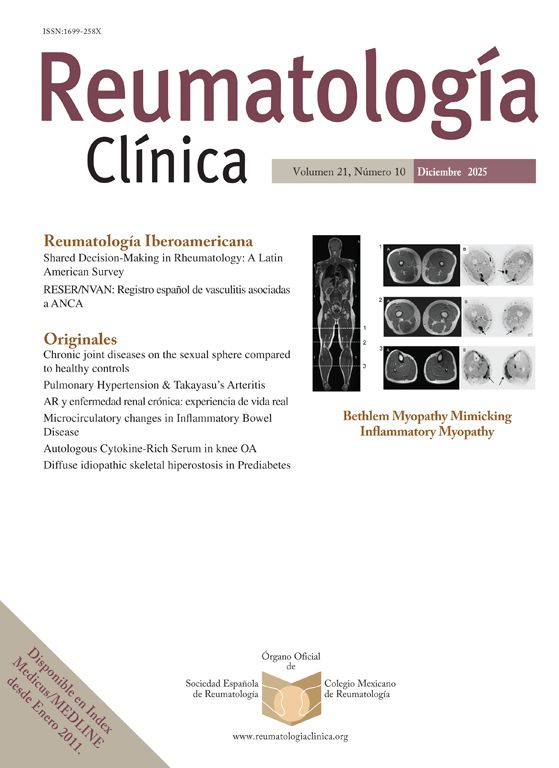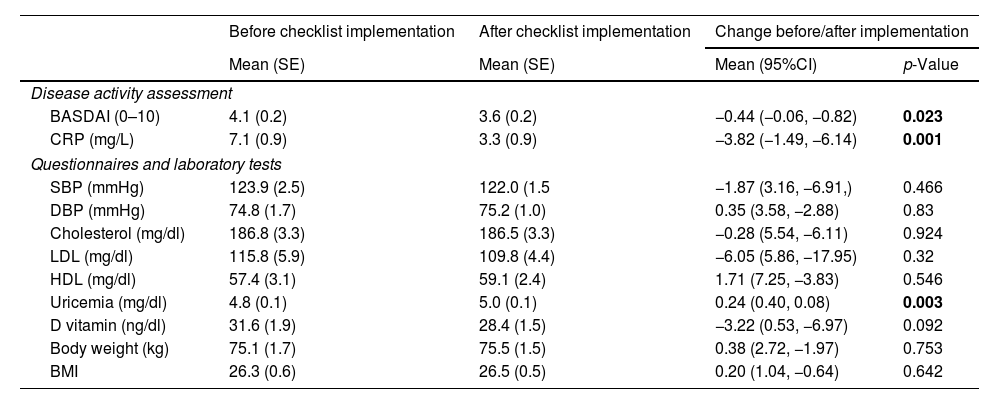To assess the effectiveness of a checklist for disease activity and comorbidity control in patients with axial spondyloarthritis (axSpA).
MethodA quasi-experimental retrospective multicentre pre-post intervention study was carried out in Spain between 2016 and 2022. Improvement in disease activity and comorbidity status was determined before and after the implementation of a checklist control in patients diagnosed with axSpA. Disease activity was determined by means of Bath Ankylosing Spondylitis Disease Activity Index (BASDAI) and C-reactive protein (CRP) levels. Comorbidity status was determined by analysing several risk factors (blood pressure, body weight, blood test, etc.). An analysis of variance with mixed models between pre and post collected values was performed. The change in therapeutic level and disease status (low activity, remission) was determined by means of the Mc-Nemar asymmetry test.
ResultsA total of 108 patients with axSpA were included in the study. After checklist implementation, a statistically significant reduction in BASDAI of 0.44 (95%CI: 0.06–0.82, p=0.023) and a significant reduction of 3.82mg/L (p=0.001) in CRP was observed. Besides, an increase in uricemia of 0.24mg/dl was found (95%CI: 1.49–6.14, p=0.001), while no other statistically significant change in comorbidities was observed.
ConclusionsThe implementation of a checklist in daily clinical practice leads to a significant improvement in the control of disease activity in patients with axSpA.
Evaluar la efectividad de una checklist para el control de la actividad de la enfermedad y las comorbilidades en pacientes con espondiloartritis axial (axSpA).
MétodosEstudio multicéntrico retrospectivo pre-post intervención en España entre 2016 y 2022. La actividad de la enfermedad se determinó mediante el BASDAI y los niveles de proteína C reactiva (PCR). El estado comórbido se determinó mediante el análisis de varios factores de riesgo (presión arterial, peso corporal, analíticas, etc.). Se realizó un análisis de varianza con modelos mixtos. El cambio en el nivel terapéutico y el estado de la enfermedad (baja actividad, remisión) se determinó mediante la prueba de Mc-Nemar.
ResultadosSe incluyeron 108 pacientes. Se observó una reducción estadísticamente significativa del BASDAI de 0,44 (p=0,023) y de la PCR de 3,82mg/L (p=0,001); y un aumento de la uricemia de 0,24mg/dl (p=0,001).
ConclusionesLa implementación de una checklist en la práctica clínica diaria conlleva una mejora significativa en el control de la enfermedad en pacientes con axSpA.









